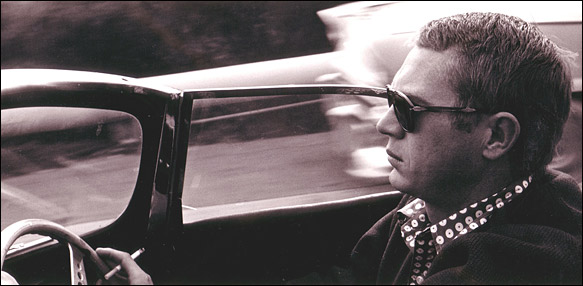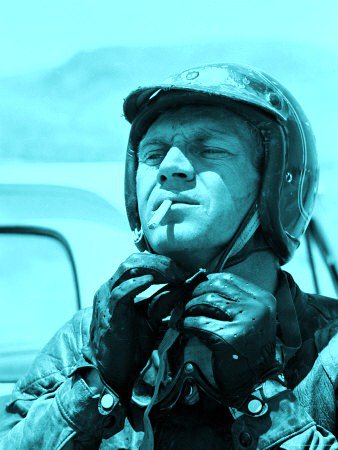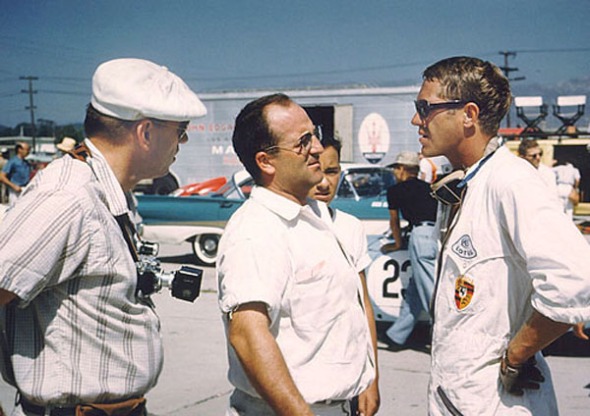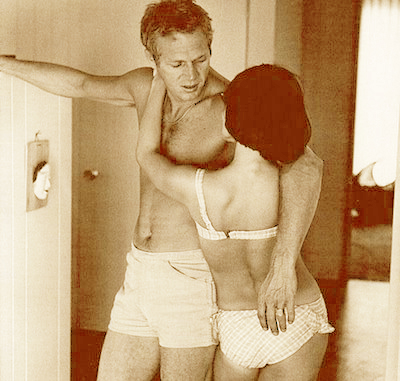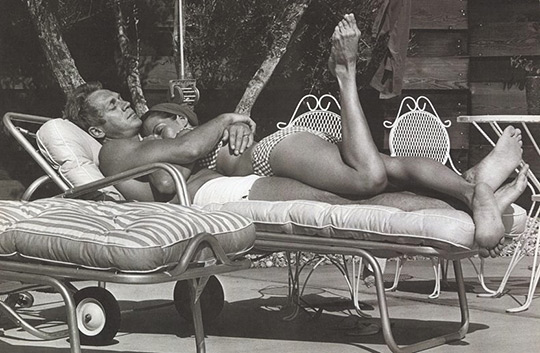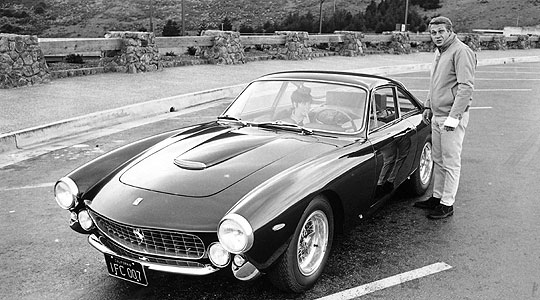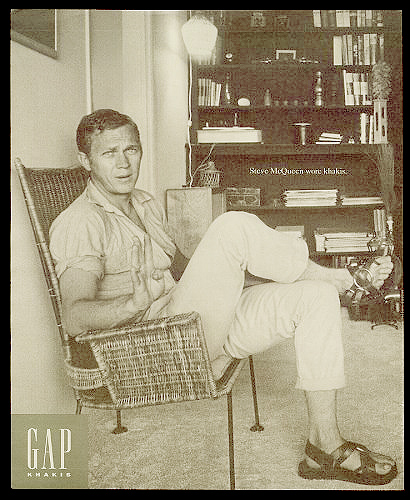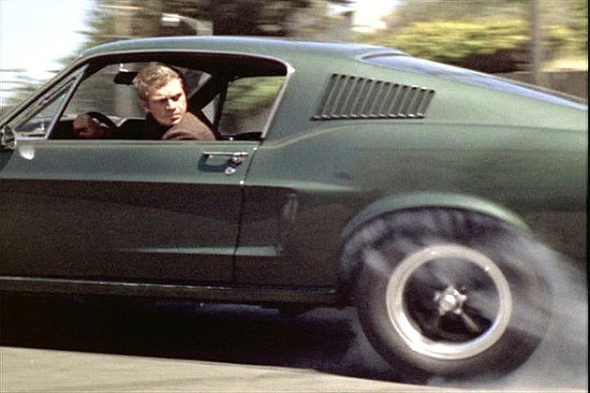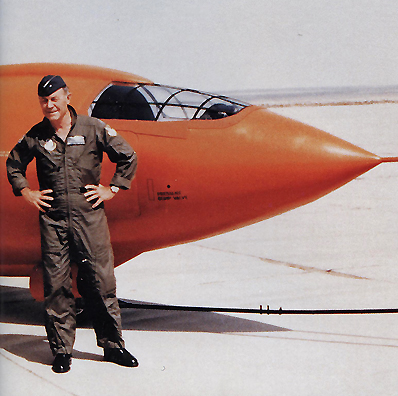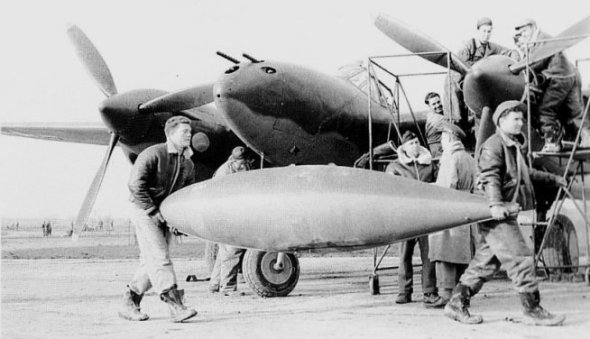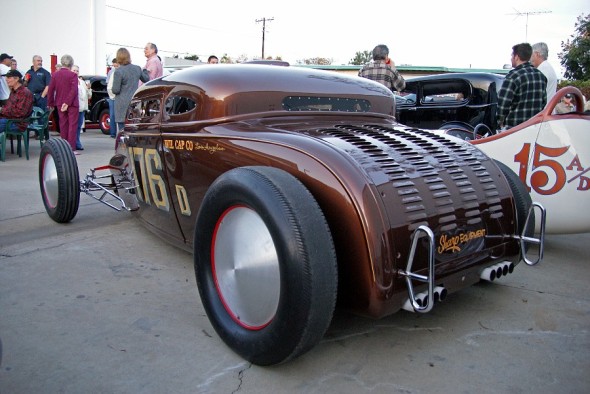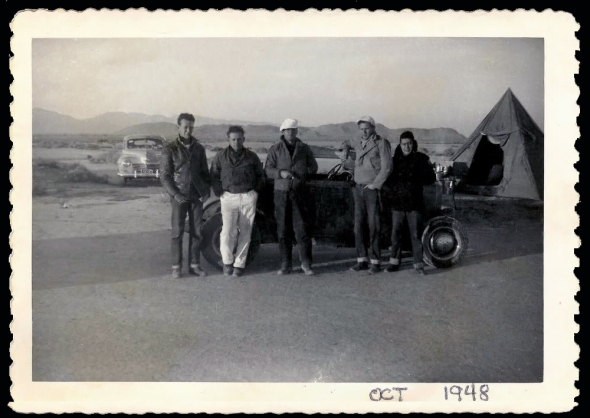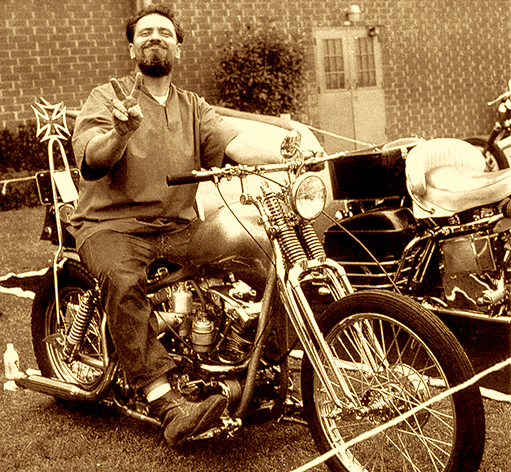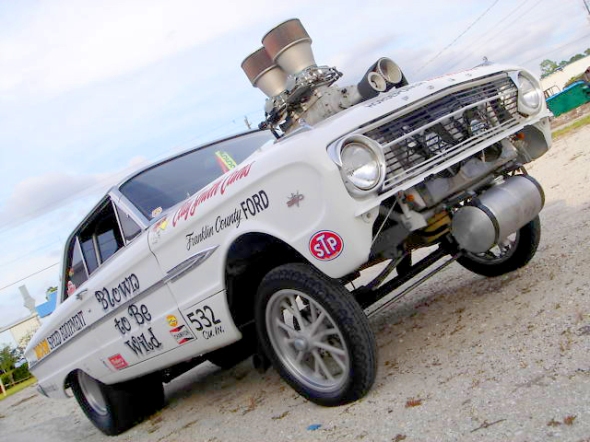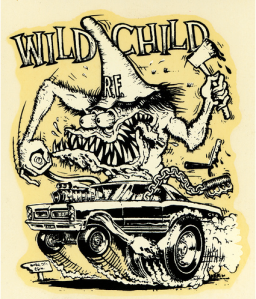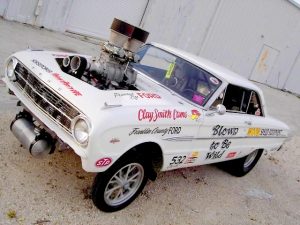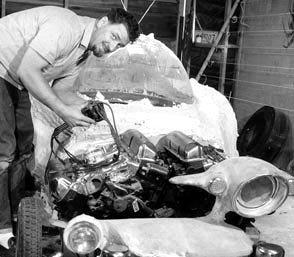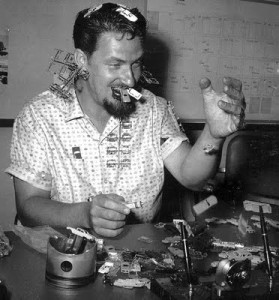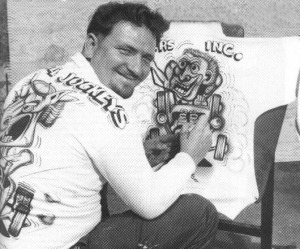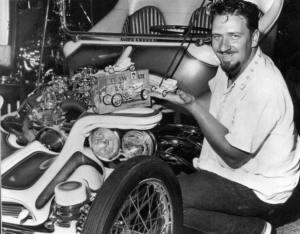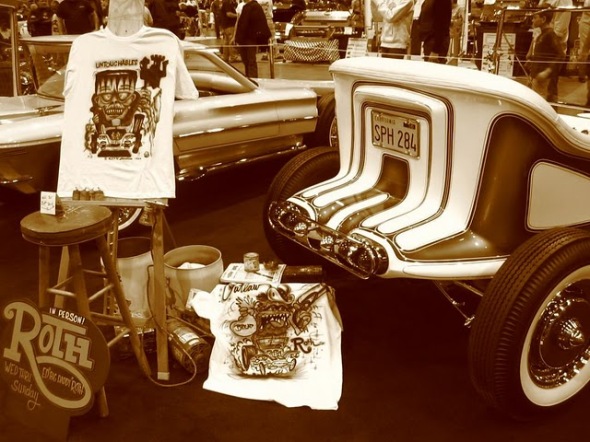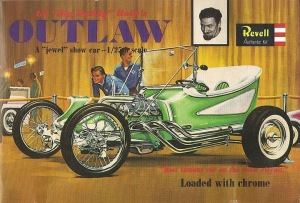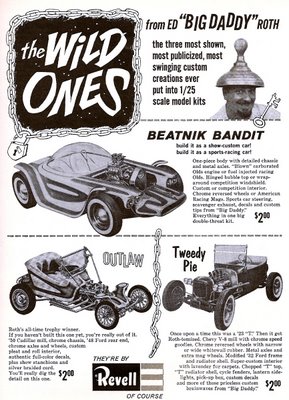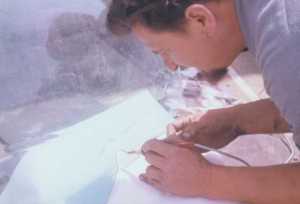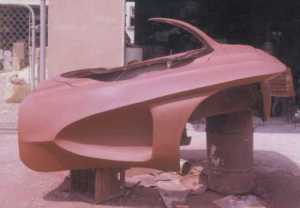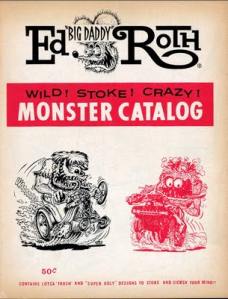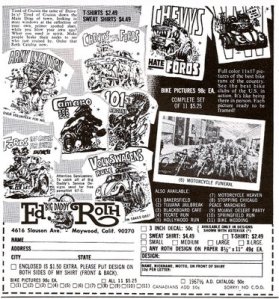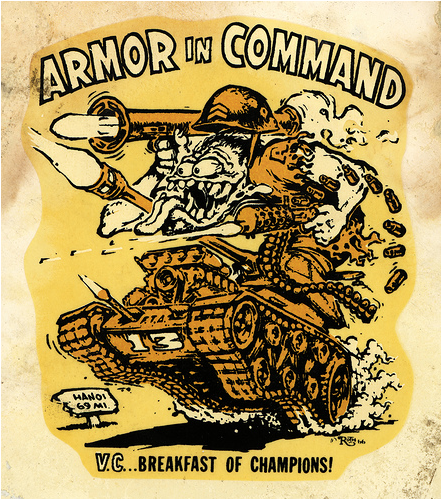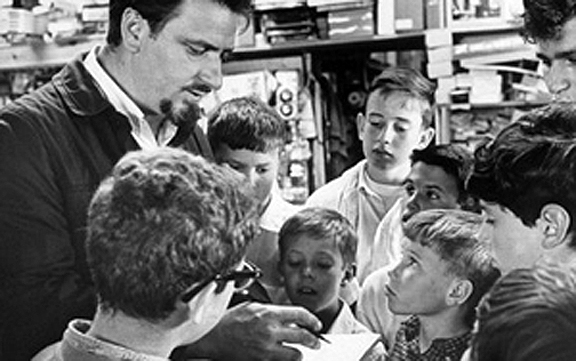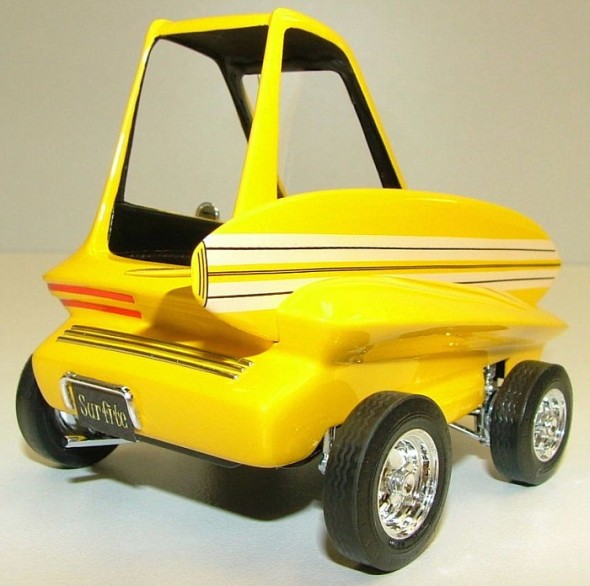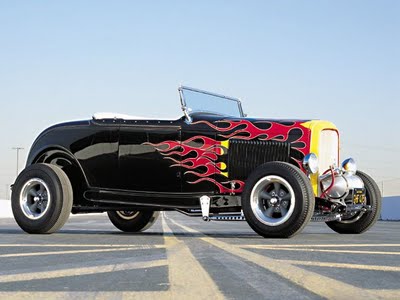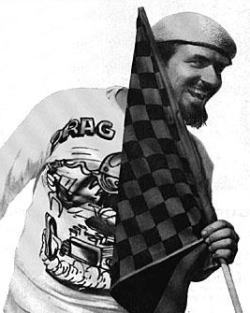The California Hot Rod ~ Survival of the Fittest on the Desert Dry Lakes 1945-2010
“It didn’t make any difference to me whether I thought the airplane would go faster than sound. I was assigned as a test pilot on it, and it was my duty to fly it…”
~ Chuck Yeager
“Some dang fool gave me a roadster when I was 14 and ruined my whole cotton-pickin’ life”, begins Dick Kraft on his entry into the world of California Hot Rods. “Then, I had a ‘29 Model A with Kelseys and a Winfield head that I paid for by working on the family ranches. I wasn’t getting anywhere [with the four-banger] so I bought a ‘32 roadster with side mounts and 18-inch wheels for $200. In high school, we had a car club called the Plutocrats. Every Saturday night, we would street race to hold [onto] our number-one status.” Street racing was (and is), is a part of Hot Rod History. The Legends of the Sport didn’t become heroes by collecting stamps – as kids they were racers…” ~ Dick Kraft
Although The Birth of California Hot Rodding pre-dates WWII, on the Dry Lakes & on the Streets of California ~ The War actually accelerated the growth of the Sport. With the Further Development of the Ford Flathead V-8 engine – The U.S. Army ran ’em in their Tanks and the larger displacement Lincolns and Packard engines ended up in America’s PT-Boats and Fighter Planes. All sorts of bits from the California Aircraft Industry ended up in Hot Rods after the War, including the Pilots. Indeed the ‘Belly Tank’ Dry Lakes first ‘StreamLiners’ were fabricated from the auxiliary fuel tanks used by WWII Fighter planes like the Lockheed P-38, One BadAss California Hot Rod in its Own Right, but that’s Another Story…
After 5 years of Hell-Bent Survival of the Fittest on Land, Sea & Air, California Boys had to find a way to Quench the Need for Speed, and California Hot Rodders took to the Air & Land in the Dry Desert Air in the Pursuit of Performance ~

California HotRodder Don Montgomery, 1948 ~ sporting a pair of WWII-style Bausch & Lomb Air Force issue shades, the 1st 'Ray-Bans'
And Indeed 65 Years Later, The Survival of the Fittest California Dry Lakes Hot Rods reached what Most Aficionados would consider the Pinnacle of Automotive High Style ~ The Hallowed Ground of the Pebble Beach Concours D’Elegance, 2010. The Iconic California Dry Lakes Roadsters And ‘Belly Tankers’ have since been restored to the Nth Degree… Far More Refined & Coveted in their Appearance than the All-Business Originals. However what Really Shines Through the Gloss, Pomp & Circumstance, The Caviar & the Champagne of the Greens of Pebble Beach is This. The California HotRodders, after enduring Years of Toil, War, Death & Destruction, came home to California to Create a Culture that was celebrated Then & Today for the Pursuit of Engineering, Design & Performance Excellence in the Thin Air Desert Dry Lakes of California ~
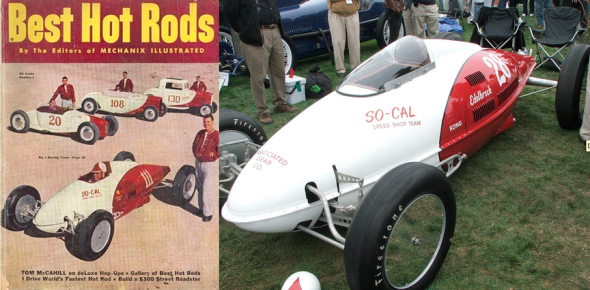
The So-Cal Speed Shop Team makes the Cover, 1950., & The So-Cal Speed Shop 'Belly-Tanker' today, Pebble Beach Concours D'Elegance 2010

The Evans Equipt '27 T-Bucket Modified Roadster ~ El Mirage 1950 & Pebble Beach Concours D'Elegance 2010
Perhaps the Greatest Honour that can be bestowed on these California HotRods today is after years of racing, knuckle-busting, scraped together with bits leftover from Woe-Begotten World-War II Surplus by Men toiling in the California Desert Dust, Heat & Cold in the Pursuit of nothing more than Every Last Bit of Speed…Years of Neglect & Idleness, and finally these Rolling Works of Art take their place beside the Bugattis, Ferraris, Mercedes & Duesenbergs of the Classic Automotive Stratosphere, representing their Time & Place as California Art ~

The Shadoff Special/CT StreamLiner ~ World Speed Record Holder, Bonneville 1953 & Pebble Beach Concours D'Elegance 2010
Special Thanks to Jalopy Journal.com /H.A.M.B. , Kustomrama.com, and Jimmy Bs 1925 Chev’s photostream on http://www.flickr.com for photos in the post ~
Who Was the Best Pilot I Ever Saw ? ~ 50 Years of Badass California HotRodders • A Gallery
California has long been called the Birthplace of Hot Rodding…
In his Book, The American Hot Rod, Iconic California Hot Rodder Dean Batchelor illustrates that, while the ‘Classic Hot Rod’ may have been a ’32 Deuce Roadster with a Hot Flathead, the Real California Hot Rodders knew of, Appreciated & were Enthusiasts of all types of MotorSport – Sports Car Racing, Dry Lakes, Motorcycling, Drag Racing, and all that entails. Mind you, NASCAR had not even been founded on the beach at Daytona when Mr. Batchelor and many other California Hot Rodders were going about the Business of Speed ~ so here, an ongoing Gallery of Images of some of the most Badass Hot Rods and the Californians that Shape the Sport ~
Although there are so many California Men & Women that define the term ‘Hot Rodding’, there are a few that have excelled far beyond their original California HotRod Roots to become International Icons of MotorSport. Santa Monica, California Boy Phil Hill was the First (of only 2) Grand Prix Formula 1 World Champions for the United States ~ Considered by many to be the Pinnacle of MotorSport. Phil Hill accomplished this in 1961. Long Associated as a Driver for Ferrari the Iconic Italian Scuderia run by Notoriously European Elitist Enzo Ferrari. For Phil Hill to be recognized as one of the Drivers in an Era Completely Dominated by European Drivers & Teams, to win Grands Prix, much less the World Championship in that atmosphere is a True Testament to Phil Hill’s Driving Skill. In 1960 he won the Italian Grand Prix at Monza, for Ferrari, The first Grand Prix win for an American driver in nearly forty years, since Jimmy Murphy won the 1921 French Grand Prix. His Primary Career Victories are Simply Astounding for any MotorSports Driver in any form of the Sport ~
- 24 Hours of Le Mans (3) : 1958, 1961, 1962 12 Hours of Sebring (3) : 1958, 1959, 1961 1000 km Buenos Aires (2) : 1958, 1960
- 1000 km Nürburgring (2) : 1962, 1966 F1 Italian Grand Prix (2) : 1960, 1961 F1 Belgian Grand Prix (1) : 1961
One of the Most Talented, Winningest & Versatile California HotRodders Ever ~ Dan Gurney.
As a driver, Gurney scored Practically Countless Victories in the sports car races at Daytona, Sebring, the Targa Florio, the 1000 km at the Nurburgring and Le Mans. He won four World Championship Grand Prix races, in France, Belgium and Mexico, three additional Formula 1 races, seven USAC/Indy Car road races and five NASCAR 500 Stock Car races. He was twice runner-up in the Indy 500. Gurney has the distinction of being the only U.S. citizen in the 100 year history of Formula 1 racing to win a World Championship Grand Prix in a car of his own construction.

Dan Gurney in the AAR Gurney Eagle ~ The First American to Win F1 with an American Car of his design ~ 12 Jun 1966, Spa-Francorchamps, Belgium
Dan Gurney’s All American Racers is the only constructor in the U.S. that has designed and built a winning F1 grand prix car, The Gurney-Weslake Eagle. A variant of-winning Indianapolis 500 car and a winning sports car. The All American Racers’ factory team employed 66 drivers winning 78 victories, the “Indy 500,” 83 pole positions and eight Championships.

Dan Gurney & Harry Weslake- Developers of the First American Engine to win at Formula One ~ Brands Hatch 1967

Drag Racing Legend ~ SF Valley Boy, A Teenage Don Prudhomme in the Tommy Ivo 4-engine Dragster. Early 1960's
The HotRodder’s Hot Rodder ~
In the 1950’s & 60’s of California HotRodding, there really were no Corporate Sponsors or Big Paychecks. Guys like Mickey Thompson built what they had and ‘Run What They Brung’ to Pursue Speed, often with very little budget. Mickey Thompson built, ran and financed a Succession of Successful Hot Rods in Drag Racing, Off-Road and his Pursuit of the Land Speed Record at Bonneville.
He developed a brilliant career as both a driver and an Innovative Automotive Technician; later as a designer, manufacturer and seller of racing and performance equipment. In addition to being a Drag Racing Champion, Mickey Thompson set more speed and endurance records than any other man in automotive history. He is credited with designing and building the first slingshot dragster in 1954, moving the seat behind the rear axle to improve traction when the existing racing tires proved unsuitable.[1] A change so momentous in the Sport, it would not happen again until Don Garlits introduced the Rear-engined Dragster in 1971.[2] Thompson also was noted for being the first manager of Lions Drag Strip near Long Beach, California in 1955.
In his long career, Thompson raced everything from stock cars to off-road vehicles and engineered numerous competition engines. He went into the performance aftermarket business in the early 1960s and then, in 1963 he created “Mickey Thompson Performance Tires” that developed special tires for racing including for Indianapolis 500 competitors.
Thompson founded SCORE International in 1973, a sanctioning body to oversee off-road racing across North America. He and his wife Trudy formed the “Mickey Thompson Entertainment Group” (MTEG) which ran an indoor motocross and off-road vehicle racing show and competition that brought the sport from the back-country terrain to stadiums in the heavily populated metropolitan areas.
The Fastest Man Alive…
The Spirit of America
 Incredibly Driven California Hot Rodder Craig Breedlove was Driven to Pursue his Quest as Fastest Man Alive in 1962. In Pursuit of the Land Speed Record ~ Breedlove set out to Build and Field the Fastest Car on Wheels, The Spirit of America. Breedlove was and Is to This Day so Incredibly Driven to Build the Ultimate Bad California Hot Rod, he built it in his garage, simultaneously putting on suit & tie while pursuing Big Financing to Keep his Project Alive and meeting with Suits from Goodyear and Shell Oil. In a Succession of Cars, Breedlove Won & Lost & Won Again his Quest for Fastest Man on Wheels –
Incredibly Driven California Hot Rodder Craig Breedlove was Driven to Pursue his Quest as Fastest Man Alive in 1962. In Pursuit of the Land Speed Record ~ Breedlove set out to Build and Field the Fastest Car on Wheels, The Spirit of America. Breedlove was and Is to This Day so Incredibly Driven to Build the Ultimate Bad California Hot Rod, he built it in his garage, simultaneously putting on suit & tie while pursuing Big Financing to Keep his Project Alive and meeting with Suits from Goodyear and Shell Oil. In a Succession of Cars, Breedlove Won & Lost & Won Again his Quest for Fastest Man on Wheels –
The Spirit of America was the first of the modern jet-propelled record breaking cars, built with a narrow stream-lined fuselage, three wheel chassis, and most significantly turbojet engine. Like most of the other competing vehicles the engine was ex-military, the first Spirit had a General Electric J47 engine from an F-86 Sabre and was tested at Bonneville Salt Flats in 1962, where difficult handling resulted in failure. Before trying again a new stabilizer was added and a steerable front wheel.
Breedlove set his first record on September 5, 1963 at Bonneville, the first man to set an average speed of over 400 mph during a land speed record.[1]
With 5,000 pounds of thrust, The Spirit wasn’t just pretty, it was fast. On Oct. 5, 1963, clocking a two-way average of just over 407 mph, Breedlove brought the land speed record back to the United States for the first time in 32 years. He broke records with Spirit of America until October 1964, when, at more than 500 mph, his chute snapped off. The car overshot the track, smashed through some telephone poles, skipped across a saltwater pond and sank like a stone. Breedlove walked away wet, but unscathed, and with a record — 526.28 mph. He’s the only driver to nearly drown while setting a land speed record.
A new Spirit was built over 1964-65 to attempt to beat Arfons, dubbed Spirit of America – Sonic I a four-wheel design with a much higher rated GE J79 engine originally from an F-4 Phantom, the same type as that used by Arfons’ Green Monster. Competing for the LSR over several years with Arfons ended with Breedlove setting the record at 600.601 mph (966.574 km/h) on November 15, 1965, a record that stood until 1970. The Sonic I is currently on display at the Petersen Automotive Museum, California.
After a lengthy break from world records Breedlove began work on a new Spirit in 1992, eventually named the Spirit of America Formula Shell LSRV. The vehicle is 44 ft 10 in long, 8 ft 4 in wide, and 5 ft 10 in high (13.67 m by 2.54 m by 1.78 m) and weighs 9,000 lb (4 t), construction is on a steel tube frame with an aluminium skin body. The engine is the same as in the second Spirit, a GE J79, but it is modified to burn unleaded gasoline and generates a maximum thrust of 22,650 lbf (100.8 kN).

The first run of the vehicle in October 28, 1996 in the Black Rock Desert, Nevada ended in a crash at around 675 mph (1,000 km/h). Returning in 1997 the vehicle badly damaged the engine on an early run and when the British ThrustSSC managed over 750 mph (1200 km/h) the re-engined Spirit could do no better than 676 mph (1088 km/h). Breedlove believes the vehicle is capable of exceeding 800 mph (1,200 km/h).
Breedlove sold the Spirit of America Formula Shell LSRV to Steve Fossett, holder of many sailing, ballooning and other aviation records, and the car was undergoing rebuilding in hopes of some preliminary shakedown runs in late September 2007 at Bonneville. However, Steve Fossett went missing in early September 2007 while scouting for alternative land speed record venues in Nevada, and his body then later recovered.[2]
To Be Continued…

Beach City Chevrolet Fuel FunnyCar 'Vette, 1969 ~ Evil HotRods & Evil Girls are 2 of a Kind, Long on Horsepower, Long Legs & Hard To Handle. Totally Worth It.

Too Hot to Handle ~ Tom Pre-'Mongoose' McEwen in Evil Handling Mid-Engine Hemi-Cuda, which would soon Wind Up Shiny Side Down, 1966
Steve McQueen & America Take on the World ISDT • East Germany 1964
The International Six Days Trial is considered the Olympics of Motorcycling ~ and Rightfully So. An Endurance Contest of Six Days’ riding over Extremely Challenging Terrain & Weather by 5-man teams from Many Countries of the World. The Trials are a True Test of Man, Machine, Skill, Endurance and Reliability.

Going for the Silver Vase ~Mssrs. Steen, Bud Ekins, McQueen, Coleman & Dave Ekins after Day 1 • East German ISDT, 1964
1964
International Six Days Trials
East Germany

Must Be Rough • McQueen Styling It around England on a Brand New Triumph street TR6 from the Meriden Factory ~ Just prior to the '64 ISDT
The ISDT was first held in 1913 at Carlisle, England. It has occurred annually, apart from interruptions due to World War I and World War II, at various locations throughout the world. Up until 1973 the contest was always held in Europe. In 1973 it travelled for its first overseas jaunt the United States. Since then it has been outside Europe more frequently: twice in Australia (1992 and 1998), once more in the USA (1994), Brazil (2003), New Zealand in 2006 and Chile in 2007.
The event has attracted national teams from as many as 32 different countries in recent years. Over its long history the rules and conditions have changed to keep in step with the developments in the sport, but it remains a supreme test of rider and machine. Over the six days and upwards of 1250 miles a rider must contend with strict rules about time allowances and restrictions on mechanical replacements, carrying out his or her own track-side repairs. One must not arrive at a Prescribed Checkpoint either too early, nor too late, and doing either necessitates a penalty or deduction of Points from a Total Given at the Outset of the Event. Rider & Machine must carry all requisite spare parts, tools and equipment as required and needed for each day’s ride on their motorcycle. If a Team Member receives Assistance of Any Kind during roadside repair, even as much as being handed a tool by an onlooker or a Sip of Water, that Rider will be Disqualified from the Event. The Remaining Team Members must carry on Without Him.
McQueen & One of the World’s Most Famous Motorcycles • Triumph ISDT TR6SC
In 1964, Iconic Motorcyclist First ~ Steve McQueen~ Actor Second, was chosen along with 4 of the Best American Off-Road Riders of the Day to Represent the United States in the 1964 ISDT in East Germany. His Teammates were Brothers Dave & Bud Ekins from Hollywood, John Steen and Cliff Coleman.
Californians All ~
Bud Ekins • One of the Greatest & Most Famous Motorcyclists ~ Ever
During the late 1950s and early 1960s, Bud Ekins was the undisputed “King of the Desert” and offroad races, with wins at all the major races including the famed Catalina Grand Prix in 1955, where he took almost 10 minutes off the race record time. He won the offroad Big Bear Run in California three times, most memorably in 1959, covering the 153-mile course over half an hour ahead of the second-place rider, despite getting a flat tire and breaking a wheel.
Ekins competed in seven International Six Days Trial (ISDT) events in the 1960s, winning four gold medals and one silver — all on Triumph motorcycles. His Now Revered North Hollywood Shop has long been the California Holy Grail of Moto. He travelled to England prior to the ISDT and prepared the Triumphs for the ISDT alongside the Meriden Factory Techs, 4 650’s and one 500CC. Bud Ekins was also a founder of the famous Baja 1000, making record runs Down the Baja Peninsula-and Back.
In 1962, McQueen asked Bud Ekins to do some stunt riding for the filming of The Great Escape. Ekins was in Germany working on the film, and it was at the end of shooting that he and McQueen came up with what is arguably the Most Famous Motorcycle Stunt of All Time. Ekins – being the Master of All Things Triumph and through his Previous Supreme ISDT Performance was charged with arranging delivery of the 4 Brand New TR6SC and T100SC models collected from the Triumph Factory in Meriden for the ISDT Competition…
Bud Ekins Won 4 Gold Medals and a Silver
in ISDT Competition
According to Dave Ekins, McQueen managed to get Paramount Studios to pay for the trip by hiring his racing teammates as ‘bodyguards’ accompanying Steve to the European premier of his new movie, “Love with the Proper Stranger.” Dave E. won the Bronze Medal in the ISDT riding a much smaller displacement Triumph 500 while his Mates were All Aboard 650’s, and Flailing About at the Finish. Ekins went on to earn a second ISDT gold in Sweden in 1966 riding a Zundapp. He then won the Bronze in the West German ISDT in 1969 despite a broken rear axle.
Dave Ekins rode in 5 ISDTs in total ~ That’s a Lot of Endurance, Reliability & Skill.
The Competition

Belgian Joel Robert carrying a Broken Silencer • Riders were not allowed to accept any help for repairs and had to Stay on Course & Time At All Costs to Win, Place or even Finish.
Within a Few Short Years the Belgian rider Joel Robert would become World 500cc Motocross Champion- An Absolutely Grueling Sport at That Level ~ Robert was a Completely Dominating Rider. The Sort of Competition the Americans Rode Against. McQueen & Co. were certainly Riding on Par.
For 1964, the ISDT would take place in the Communist Eastern Bloc during the height of the Cold War. On September 5, 1964 in a packed hall in Erfurt, East Germany complete with a large picture of Lenin, McQueen ~ in what has been reported as one of the proudest moments of his life – carried the ‘Stars and Stripes’ for the US team at the opening ceremony…
A TRIP TO EASTERN GERMANY IN 1964 ~
18/03/10 –
Mr Oriol Puig Bulto, President of the FIM International Technical Panel, was a experienced off-road rider during the Sixties: he took part in nine International Six Days’ Trial events between 1962 and 1970. He was in Erfurt in 1964.
He recalls:
In Erfurt in 1964, I remember well the American team with Steve McQueen, the Ekins brothers and other riders. They had a lot of helpers, press people, cameramen, etc., and many american flags everywhere. They were doing spectacular rides the days prior to the start, going up and down and doing fast side slides with their big Triumph twins. A real show…
I met briefly Steve McQueen and Bud Ekins, they were nice people, very accessible and ready to share experiences and fully enjoy the event. In my opinion, all members of the US Team were good riders, very much used to ride in the desert and in dry terrain but not so much in the muddy sections through the woods and hills of central Europe. Also, they were riding too ‘crazy’ for a six days event, crashing too much. I remember seeing Steve and some other members of the US team riding with torn mudguards and bent handlebars, and also with bruises in their faces. The best known members of the team, Steve McQueen and Bud Ekins had to retire on the third and fourth days after several heavy crashes. But other members got Gold and Silver medals.
I never met again Steve McQueen, but I had the pleasure to meet Bud Ekins in May 2007 at the ‘Legend of the Motorcycle, Concours d’Elegance’ in Half Moon Bay, California, where I was acting as a Judge and Bud was the Honorary Judge. Bud was in serious health condition but we had the opportunity to remember together ‘those old glorious times’, few months before he passed away in October of that year.”
And So it Went ~ Cliff Coleman achieved 3rd place in the 750cc class and Dave Ekins gained 5th place in the 500cc Class that year. Bud Ekins and Steve McQueen both crashed out on the third day, Ekins with a broken ankle. The Steve McQueen bike has been rediscovered and is now owned by Sean & Catherine Kelly of Johnson Motors, a Re-created Apparel Biz in Pasadena, California very much in the Tradition of The Esteemed California Triumph Motorcycle Dealer of the Same Name – that Mssrs. McQueen, The Brothers Ekins, Steen and Coleman frequented in their Days of Glory in 1964 ~
The BadAss California HotRod Boys Took On The World’s Best ~
Thou Shalt Drag ~ “Big Daddy” Roth Lives ! A California Genius in his Heyday • 1963
Although this Modern Day Badass Hot Rod was not built in California ~ The Style it Embodies is completely a la Ed “Big Daddy” Roth 1963…
And California-Style It Is…Having seen, owned & been exposed to A Lot of Hot Rods, Federico had to admire Blown to Be Wild for the Sheer HotRod Audacity, Craftsmanship & Total Big Daddy RothNess of a Monster Car Come to Life ~
Though we now use any manner of digital technology to create Modern Art, preserve Nostalgia, Pop Culture & Retro-Everything, ( which I am Shamelessly Guilty Of ), One of the Most Iconic California Pop Maestro MasterMinds, Mr. Ed Roth, like Mssrs. Matisse, Picasso & Dali before him, gazed for the most part Wholly and Phantasmagorically Into the Future. None of these Neo-Artistes sat and lamented on Things ‘Back in the Day’, but completely without the aid of computers or digital devices of any kind, Roth created a FantasyLand of FantasticNess we now Worship as California High Art …and Rightfully So ~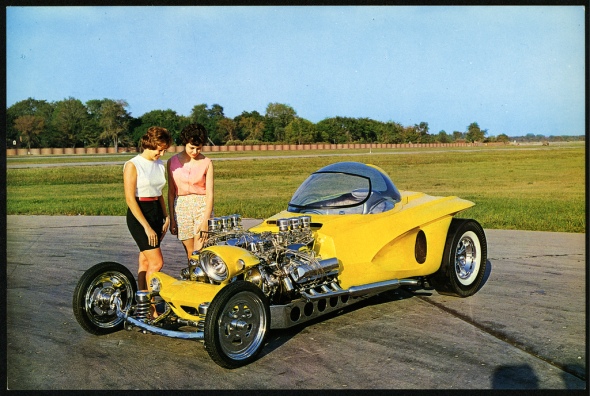
Big Daddy embraced a wholly original technique d’art. Using Plaster of Paris to create a master shape for his Outlandish California Creations, he would hand form a molten batch of Goo into a hardened Futuristic Shape and cover it all with FiberGlass, a relatively new media technology developed during World War II. What would begin as a Big Mess on the floor, Roth would transform into a Rolling Renaissance Machine, like “Mysterion” above, built in 1963 and “Beatnik Bandit”, below in 1960.
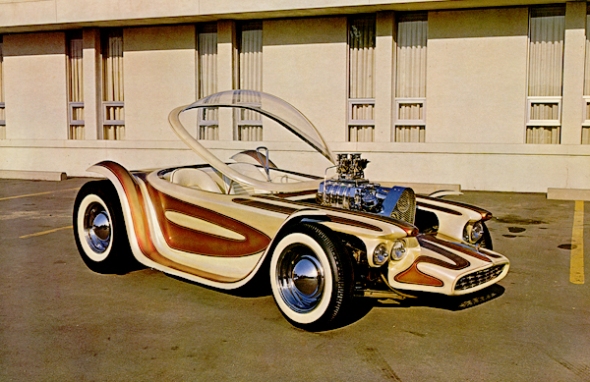
Roth's Beatnik Bandit - controlled by a central 'Joystick', (no steering wheel) and hand-blown bubble top, 1960
” In Africa I had got this fantastic idea for a fiberglas car when I saw a picture of Henry Ford beatin’ the trunk of one o’ his new ’41 Fords with a sledge hammer and it wouldn’t dent. Ya could’a knocked me over with a feather. It was also very cheap! It could also be done by people with little or no talent and I had both. It seemed too far out for my brain so I just dismissed it ’til I saw the LIFE article. In ’57 I started playin’ with ‘glas’. I got some of the gooiest messes ya’d ever wanna see. My pants are always ruined by the end of each day, but in them days I’d have to throw ’em away each day. Shoes was good for about 4 days before I’d throw a coat of black paint on ’em.”
“First I had the frame which was your basic ’29 Ford rails and fitted this junk Caddy engine into (junk but ran good). I knew fiberglas existed but couldn’t get anyone to help me (except Dirty Doug later on) so I was gonna make me a body outa wood like the Shadoff Special guys’d done. But it was too complicated and besides, wood and me don’t jive! So I went to the local lumber yard and got some casting plaster (which is gross ’cause it dries so quick) but it was cheap and better’n wood.”
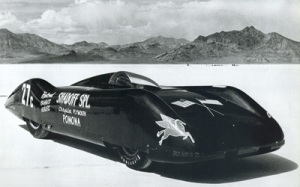
The Shadoff Special ~ Bonneville Speed Week, 1953. Body of fiberglass over a wooden 'buck' or frame, built by Dean Batchelor. One of the most successful 'Streamliners' of its day.
“Makin’ the buck was no problem. Guys in Detroit was usin’ clay since the early 20’s but clay was a buck a pound. Forget it! Plaster was a buck for 100 pounds. I used that! Then I covered the plaster with this messy, ooey, gooey stuff. I mean, like, it just ran into this big pile of mush on the asphalt. It was devastating.”
From “Hot Rods By Ed ‘Big Daddy’ Roth”/Roth,Thacker 1995
Early Big Daddy – hand airbrushing Monster Shirts, pre-Fame and screenprint days. Above right, Justifiably Proud Big D with Outlaw, 1956-60. His 1st FiberGlass car, and its Offspring, the Revell licensed model kit of it you can still buy today.
Gazillions of the model kits were made of several Roth creations..and for a while at least, in His Heyday, Big Daddy was makin’ Big Bucks..He had literally Created a Monster and Mysterion defined the Early 60’s California Hot Rod Era ~

Big Daddy outside his Maywood shop, circa 1960
Roth built Most of his Masterpieces along with producing his T-shirts at Roth Studios, his very Low-Techy Mad Scientist’s Laboratory on Slauson Avenue in Maywood, an L.A. suburb. Revell American produced model car kits that featured the “Beatnik Bandit” and “Road Agent”. Other model kits included “Rat Fink” and the gang, a group of hot rodding monsters. During 1963 Revell paid Ed “Big Daddy” Roth a one cent royalty for each model sold. In 1963 Ed brought in $32,000 that year in royalties, that’s a lot of model kits…
Big Daddy Ed, The Old World Craftsman, built his California Creations almost single-handedly in his small shop, heating and blowing Plexiglas Bubble Tops for his Masterpieces in a pizza oven, like some Mad Venetian GlassBlower Time Travelling to Shakey’s ~
Later On he got so busy he hired a few Dedicated Employees, guys like Dirty Doug, Robert Williams and Ed ‘Newt’ Newton, who drew most of the Cool Monster T-shirt designs. Years later, Roth would work with Moldy Marvin, who carries on the Roth Legacy, maintaining ‘All Things Roth’ to this day.
Roth was Getting So Big he started printing Catalogs – Perfect Reading During 4th Grade Math Class…

BDR at the Office ~ Drag 'T' ,Rat Fink Hat & a Sea of Silkscreens behind him...Dress for Success !
His lightweight, rear-engine Space-Age Road Agent, used a rear-mounted Corvair engine and ultra-light construction, you’ve gotta love those StarTrek pods on the sides….preceding the StarShip Enterprise, which wouldn’t be seen on the new T.V. show Star Trek for another 2 years…
Big Daddy, no Average Beatnik – demonstrated a Stroke of Pure Genius completely devoid of Modern Technology….i.e. arguably the first use of what we know as ‘RGB’ color in a non-printing application, with the lighting on his Orbitron, below, 1964. An excellent article on Orbitron is here :
http://www.ratfink.org/orbitron/history.htm

Roth's Orbitron ~ lost for years, and found recently outside a Mexican adult bookstore & restored...ever heard the term 'RGB' with relation to computer color? Roth's 3 headlights produced a white beam, in 1964. Roth felt the car was "a failure at the shows..." for not having its chromed Corvette engine exposed.
Big Daddy had a family to support. He had quit his job as a Window Display artist at Sears-Roebuck and financed his Custom Car Creations work through sales of the ‘Monster’ T-shirts, travelling around to various Custom & Hot Rod Shows and related events for years, parlaying his designs into lucrative licensing agreements with Revell, for the Model Kits. Today we think of the T-shirt, with any manner of design on it, to be anywhere from ‘Designer’ couture – as in a simple black petite ladies T-shirt with ‘Prada’ on the front, to a 12 year-old’s latest Volcom ‘Surfwear’ 18-color-cool-for-a-week-design.
Every time you see some ‘Metal’ or ‘Punk’-flavoured design or ‘Urban’ streetwear, and All the Kids and Half the Adults are ‘rocking’ Cool Skulls-this-or-that, you’ve got Big Daddy Roth to Thank, because he Did it First…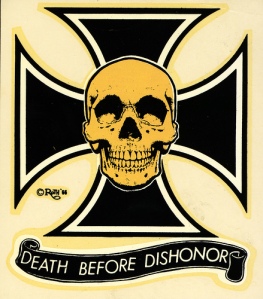
Roth did his original shirts by hand, graduating to silkscreens in one to 3-4 colors, a contemporary of Mr. Andy Warhol with regard to screenprinting technology. Considering a Warhol screenprint is now worth several hundred-thousand to millions of dollars – at the same time Big Daddy was knocking out hundreds of screenprints, all the while producing 3-dimensional full-size Rolling & Driving Works of Art.

Genius at Work ~ Roth and "Rotar", motorcycle-powered hovercraft, 1965. Would it fit Obama's programs to develop 'alternative energy' today? Quite possibly.
Another often overlooked aspect of Big Daddy’s Intellect were his sometimes subtle to blatant messages to Us Kids on the subjects of Anti -War, Question-Authority, yet showing Respect to Soldiers, Servicemen & Country, Government, Cops, The Establishment & encouraging us to ‘Stick It to the Man’.
Of course it was All in Fun and he was just Covering All His Bases. This was 1963-1965, Vietnam was still relatively unknown to the Average Kid, but the Big Kids knew, and Roth was speaking to them too ~
Although Roth knew Full Well – Kids were his Audience, his Army in America and We Were the Future …
…he wasn’t always so Popular with the Parents..but in Retrospect – through his Crazy California Ways, his Humour with Tongue Firmly in Cheek and his Unmistakable Genius, maybe he was Right…and perhaps now one can ask – have we Learned any Lessons he was trying to Let Us in On ?
I was In The Presence of The Great Big Daddy Roth Twice. Once at the young age of my Peers in the photo above, at an L.A. Car Show, watching Roth airbrush T-shirts, just like in the photo up top there, by himself working away, covered in paint ~ a cloud of enamel haze around his head.
He obviously made an impression, as 10 or 15 years later, I was now a young Graphic Designer/Sign Maker sharing a studio not entirely different than Roth’s above with an early partner, whose Dad was Head of the Graphics and Sign Shop at Knott’s Berry Farm. Big Daddy was working there at the time, toward the End of his Career. So of course we went to see him, and I was Beside Myself. Walking into this archaic wooden, very rural-style shop left over from the Early 30’s Days of Knott’s, my expression upon meeting him was no doubt like those of the boys in that photo above, a Jaw-Dropping Idol of mine. I had been One of Those Kids. Roth had managed to Pinstripe, Flame, Scroll and Letter – in tiny script practically the entire surface of the Shop Interior with Big DaddySpeak.
With a wry grin, towering over me – he shook my hand and chatted with us for a few minutes, before mounting his Equally Vintage Cruiser Bike, also completely BigDaddy-ized with Perfect Pinstriping and Dazzling Druid Decoration on every inch of metal surface, as He Rode off on yet another Fantasy Mission into the California Sunset ~
Time is All You’ve Got • Ry Cooder & The 1952 Lakester at El Mirage Dry Lake
http://www.nytimes.com/interactive/2008/11/23/travel/23ry_cooder/index.html?th&emc=th
California’s Baddest HotRodding Family • The Chrismans ~ 1948-1965

What Was the Baddest Hot Rod I ever Saw..? Jack Chrisman in his Nitro-Burning Comet Super Cyclone~Fontana Drags, 1965
In the early 1950’s, Compton was a Respectable, Sleepy Suburb of L.A. I know, my Aunt Ruth & Uncle Bill lived there in a little white house with roses & a Bird Bath in the backyard.
Art & Lloyd Chrisman lived in Compton, too, and the Chrisman’s Garage turned out some of the Nastiest, most Innovative, Well-Designed -Built, Fast & Feared Hot Rods anywhere.
This is the Story of the Chrisman’s – California’s Baddest HotRodders.
In 1950 Art & Lloyd had been racing a modified ’32 Ford roadster on the dry lakes like Harper & El Mirage, north of L.A., near Palmdale in the Mojave. Then in 1953 they set their sights on the Salt Flats at Bonneville & built the nastiest Ford coupe they could conjure up. Based on a 1930 ‘A’ Coupe, Art & Lloyd built a very hi-tech for its day-tube frame, dropped in an injected, bored & stroked Flathead V8, running on a 50/50 Nitromethane & Pump Gas mix – behind the driver with a sectioned, lightened chop-top body channelled over the frame, and an ingenious streamlined nose made from 2 ’40 Ford hoods laid top-to-bottom, the Chrisman’s built what could be considered the world’s first Fuel ‘Funny Car’. A design concept basically shared by all Fuel dragsters & Funny Cars racing today, over 50 years later. but no one knew that…yet.
In 1954 the Chrismans returned to Bonneville, with a new Ford V8 in the Coupe, and used its previous engine for the Roadster, now fielding 2 cars on the Salt, and sponsoring a third. It would be 15 years before other Race Teams would have the organization, skill and funding to field 2 and 3-car teams. Today it takes millions of company sponsorship dollars to do so. Sporting a new Super-Flathead V-8, with Ardun ‘Hemi’ heads, the predecessor to all current drag-racing engines, The Baddest Motor Scooter of its Day. With about 285-300 hp available, the Chrisman Coupe was approaching 200 mph on the salt.
In 1955 The Chrisman Boys returned again, this time with a blown Chrysler Hemi, capable of pushing the Coupe well over 200 mph. The Chrismans withdrew from competition after a friend was killed that day in another car. Shortly thereafter the Chrisman Coupe was sold, never to be raced (by Art & Lloyd) again. In 2008, the restored version of this car was sold at auction for over $500,000.00 and is displayed at the Petersen Automotive Museum in Los Angeles, not far from where it was built in the Chrisman’s Garage in Compton, not 5 miles away, 50-plus years before.

The Chrisman Coupe set up for Drag Racing, Pomona, CA 1954
Keeping it All in the Family, along came nephew Jack Chrisman, following in his Father’s and Uncle’s footsteps…in the late 50’s, Jack built early innovative race cars for the dragstrip like the ‘SideWinder’ – one of the first with a rear-engine (and sideways-mounted, for balance), preceding the current practice not widely used until 15 years after this car was first built & ran, in 1959. About 5 years later, having earned a reputation as some of the Baddest HotRodders Anywhere, and now getting some albeit, Undercover Financing from the Ford Motor Company, Jack Chrisman stuffed a leftover 427 Big-block Ford engine into a brand-new ’64 Mercury Comet. My Mom drove the innocuous economy car street version. Jack Chrisman unleashed his Monster Comet on the Drag Strip and sanctioning body NHRA didn’t even know what to call it or how to classify it, the Ultimate Sleeper – The World’s First ‘Funny Car’. Chrisman created a spectacular Mind-Blowing Crowd – Pleaser – a California Hot Rod Revolution that would set Drag Racing on its ear, and Detroit scrambling to create cars to emulate that Evil ‘MuscleCar’ Style….The Chrisman Comet Super Cyclone. A Small, Safe-looking Family Car with a 750-horsepower Monster Motor . I saw it when I was 8 years old and, having seen a lot of Hot Rods already at that age, the sight of what looked like Mom’s Car laying down 500 feet of Nitro-burning tire smoke at 160 mph changed my life forever. The Baddest Hot Rod I ever saw.
Art, Lloyd & Jack Chrisman had and would go on to build several other Winning, Feared, and ultimately Legendary Hot Rods and Race Cars over 30 years, some of which now reside in Museums. Not all are shown here – But to me, because of their innovations – and adoption of into a sport known for design, technical innovation and by nature, always moving forward – These famous Chrisman Dragsters are the most noteworthy.
The Compton, California Chrisman Boys, did first and best, initially without major financial sponsorship what would Evolve into the Multi-Million Dollar Industry that has become Today’s Spectacular Spectator Sport -Nitro-Burning Top Fuel & Funny Car Drag Racing- California Style.
True California Style…
Steve McQueen & Darryl Hannah exude true California Style…Irresistible, Alpha Individuals always ready for Action & Fun in the Sun….

